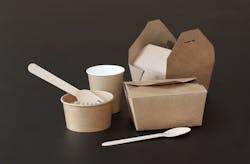Why Product Packaging is the Next Frontier of Corporate Sustainability
Every year in the United States, 63 million tons of food waste is sent to landfills, and the cost of growing, processing, transporting, and disposing of that food is approximately $218 billion. Meanwhile, according to a recent study from McKinsey, the majority of the world’s plastic waste ends up in landfills (40%) or is incinerated (25%), meaning those materials are lost forever as a resource.
Taken together, these findings underscore the urgent need for more sustainable packaging for the foods and beverages traveling across the world’s supply chains. Introducing more sustainable food packaging would not only benefit the environment but would also help organizations make progress on their corporate sustainability goals – which consumers are increasingly considering when deciding whether to patronize a business. According to Boston Consulting Group, 70% of consumers say they are willing to pay a 5% price premium for products produced by more sustainable means.
The Key Functions of Packaging
Packaging has always been a critical focus for organizations of all types for several reasons, most notably the need to preserve product quality and drive down the cost of goods.
For maintaining product quality, plastics have traditionally been very effective in preserving a wide variety of items, and for that reason, plastics are a highly popular packaging material. And while plastics are rightfully viewed with a cautious eye due to their inability to biodegrade, in many parts of the world they are a miracle-maker for keeping food fresh.
But the cost of goods is often in opposition to preserving product quality since costs are driven down by a reduction in packaging, which can jeopardize the quality of a package’s contents or result in a damaged product. As a result, the goal of organizations’ packaging strategies is to strike a perfect balance between cost reduction and quality preservation.
Organizations have become quite inventive as they aim to strike that balance. For example, grocers have begun to add labels to certain products with quick and easy recycling directions for the consumer. In the future, this could evolve into offering “sustainability profiles” that indicate how plastic-heavy a product is by using colored stamps. Meanwhile, the Netherlands has begun to experiment with “no plastic” supermarket aisles. Beyond driving sustainability, these practices also help improve branding, making a business more appealing to consumers who are increasingly aware of the environmental drawbacks of plastic.
Sustainable Packaging Innovation
As sustainable packaging increasingly becomes a key element of organizations’ corporate sustainability programs – combined with consumers’ growing focus on sustainable living – design and packaging innovation has accelerated at a breakneck speed.
One of the sustainable packaging practices that’s being widely adopted by consumer packaged goods (CPG) organizations is the switch to fully compostable materials, such as 100% biodegradable coffee cups and compostable bioplastic food wraps. Organizations are also now offering recyclable products that can withstand heat and hold liquids, such as drinkable water bottles and heat-resistant polylactic acid (PLA) plastic.
New approaches to packaging are constantly emerging, such as USDA researchers developing an edible, biodegradable packaging film comprised of milk protein casein, which can be wrapped around food to prevent spoilage. Similarly, Apeel Sciences has developed a natural coating that adds a layer of tasteless, odorless, plant-based protection onto the surface of fruits and vegetables, which helps produce last twice as long.
Another emerging sustainable food packaging practice is printing information directly on packaging, rather than applying an additional label to it. This helps food producers reduce packaging costs, waste disposal, and ultimately their carbon footprint.
Finally, recycling organization Terracycle has created Loop – an initiative that hearkens back to the days of the local milkman by delivering a consumer’s favorite products in visually appealing containers, which Terracycle picks up and refills when the customer is ready.
The Role of the Circular Economy
Many of the innovations mentioned above are examples of the circular economy, which is a key trend in sustainable packaging that refers to the perpetual reuse of materials for the production and packaging of new products. In an ideal world the packaging itself should be circular, but failing that, CPG organizations should aim to reuse packaging materials as many times as possible to maintain the integrity of the circular economy’s sustainable cycle.
Plastic’s inability to biodegrade makes it a perfect candidate for the circular economy since it is the only way to sustainably reuse the material. In addition, any packaging that directly touches food must meet strict federal regulatory requirements, and packages must also meet certain specifications to allow for temperature fluctuations and high humidity – and plastic is able to meet these requirements with ease.
Sustainability-Boosting Technologies
Technology exists today that can help augment organizations’ sustainable packaging efforts. For example, through sensors attached to shipping containers and delivery vehicles, track-and-trace technology provides real-time condition monitoring. This helps organizations prevent spoiled food from making its way onto the grocery store shelves – and remove it from the shelves if necessary.
In addition to alerting when a container’s or delivery vehicle’s contents are at risk of perishing, track-and-trace technology can identify potential theft of containers (which is a significant issue in the shipping sector). Furthermore, track-and-trace technology can help organizations improve forecasting and manage supply and demand across their food chains.
By leveraging advanced technology, organizations can help ensure that their sustainable packaging efforts aren’t negated by shipping delays or disruptions.
The Time to Act is Now
Sustainable packaging is evolving at an exponential rate, and the innovation and ingenuity we’re seeing is sorely needed. For the good of the environment, society, and economy, it’s imperative for humanity to find more sustainable ways to produce, transport, and manage the planet’s food supply. Sustainable packaging will undoubtedly play an increasingly key role in that monumental effort over the next few years and decades.
Rich Kroes is Vice President of Global Sustainability, Oracle
